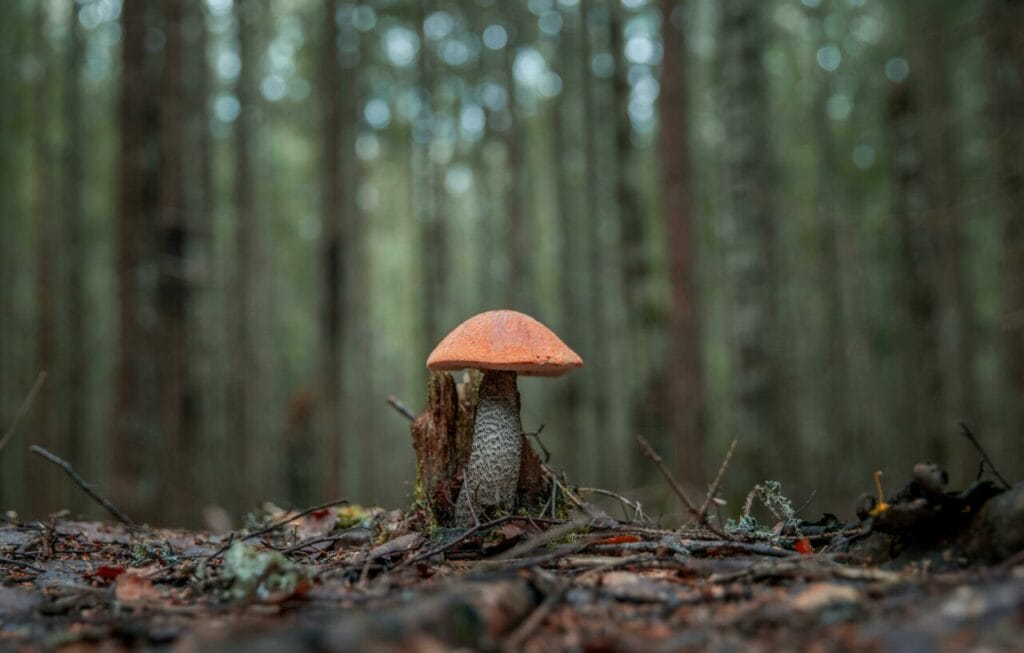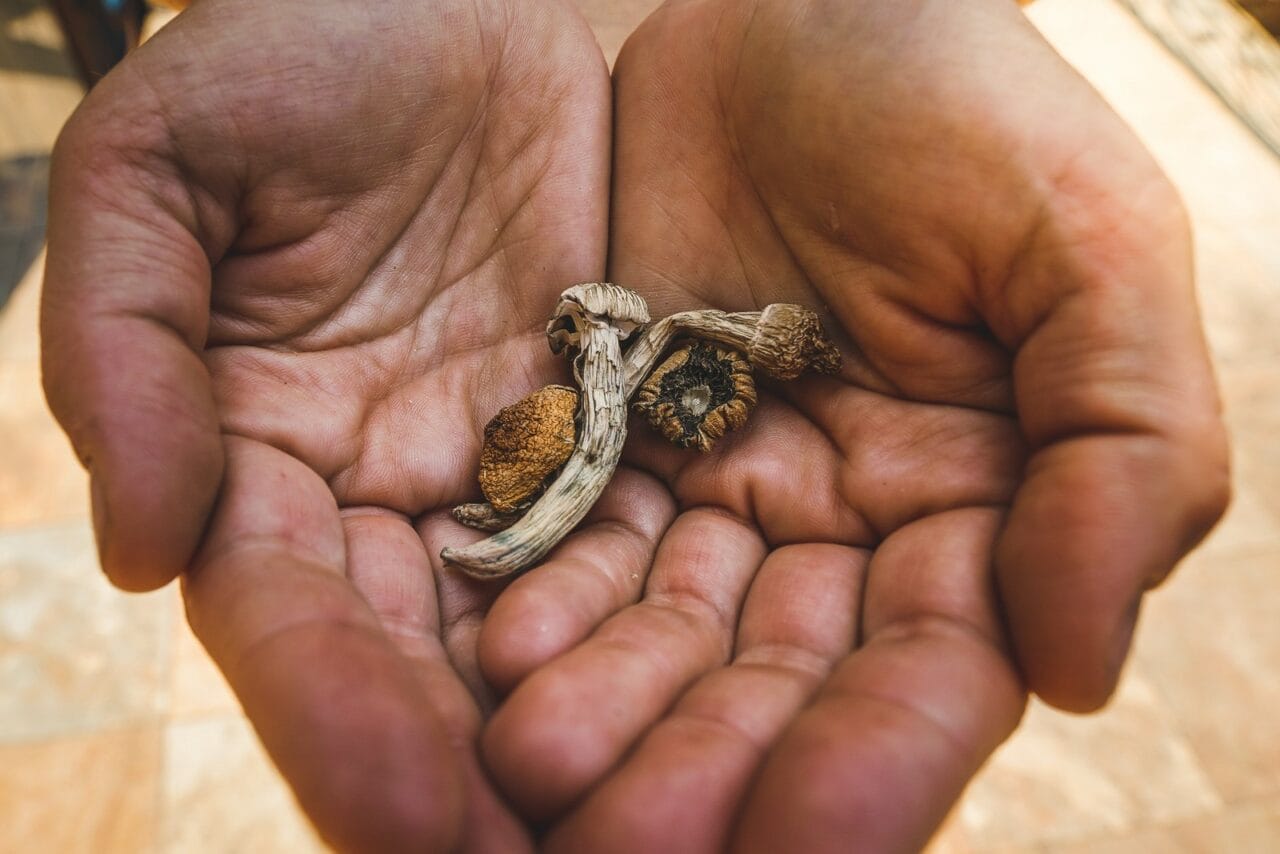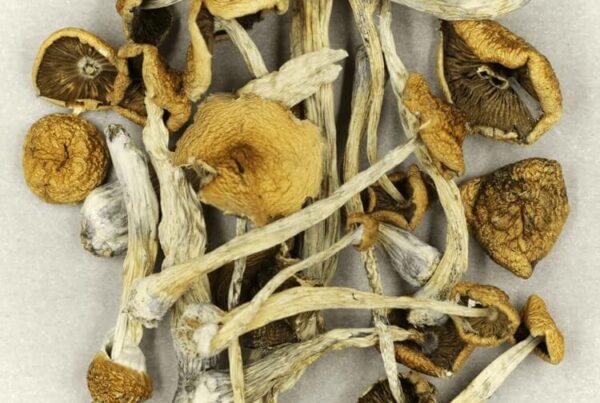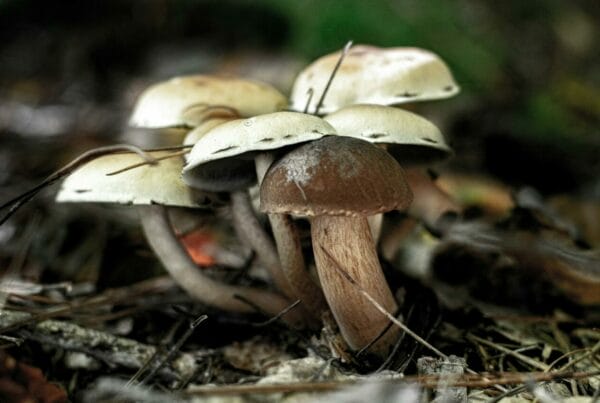Dried shrooms are among the most sought-after psychedelics in today’s market. If you’ve heard about them and considered experimenting with them, but aren’t quite sure if they’re the right match for you, continue reading.
Novices often face confusion regarding which psychedelic to begin with. We’re here to clarify the distinct characteristics of dried mushrooms compared to other psychedelics and why they could be an excellent choice for your inaugural psychedelic experience.
[toc]Key Insights:
- The primary compound in Psilocybe, it’s the most extensively studied psychedelic for mental health due to its safety, low abuse potential, and brief duration of effects.
- The most common form is dehydrated Psilocybe, which preserves potency and extends shelf life.
- Psilocybin activates the serotonin 5-HT2A receptor, inducing enhanced perception, vivid imagery, complex hallucinations, and temporal distortions.

Psilocybin Mushrooms: An Exploration of the Psychedelic Fungi World
A psilocybin mushroom encapsulates the psychoactive substances, psilocybin and psilocin, responsible for the hallucinogenic impact on users. The most recognized species—Psilocybe cubensis—displays a light brown cap, dark spots, and a distinctive shape. Various other species within the Psilocybe genus also generate these compounds.
Some hazardous mushrooms that contain toxic substances resemble the appearance of Psilocybe, which is why we caution against foraging for shrooms.
Over history, many mushrooms played a significant role in Central American spiritual rituals. Presently, their potential to treat mental health issues, including substance abuse disorders, is being researched.
Preparation and Preservation: The Dried Variant
The dried format of Psilocybe is the most widely accessible. Dehydration is vital to retain potency and extend shelf life. Fresh mushrooms are usually dried with a food dehydrator or left on a wire rack in a cool, dry area.
This process is crucial to remove excess Magic mushrooms, once dehydrated, can be stored for future use. Drying them properly prevents moisture, which in turn can lead to mould formation and deterioration of the active compounds.
Follow this step-by-step guide to effectively dry and preserve magic mushrooms:
- Use an appropriate food dehydrator or a wire rack to dry the mushrooms thoroughly.
- Preserve them in airtight containers to keep them potent and shield them from excessive moisture.
- Store them in a dry, cool place to maintain their psychoactive properties.
- Avoid exposing them to direct sunlight to prevent degradation.
- Inspect them regularly for mould or dark spots, as these are indicators of spoilage.
Comparing Psilocybe Cubensis with Other Psychedelics
In addition to dried mushroom products, there are other psychedelic products available online. These products have disparate effects on the body and can be ingested in various ways. Some of these substances are recognized as classic hallucinogens, akin to psilocybin.
| Substance | Source | Physical Effects | Potential Therapeutic Uses | Effect Duration |
| Psilocybin | Found naturally in over 200 mushroom species | Enhanced perception, hallucinations, altered sense of time | Depression, Anxiety, PTSD, OCD, Cluster headaches, Alzheimer’s disease | 4-6 hours |
| DMT | Occurring naturally in plants like Psychotria viridis | Profound spiritual experiences, visions, auditory hallucinations | Depression, Addiction | 15-30 minutes |
| LSD | Synthetic, first created by Albert Hofmann in 1938 | Intensified emotions, altered perception, auditory and visual hallucinations | Depression, Anxiety, Addiction, Cluster headaches, Alzheimer’s disease, Tourette’s syndrome, ADHD | 8-12 hours |
| MDMA | Synthetic, first developed by Anton Köllisch in 1912 | Increased release of serotonin, dopamine, norepinephrine, and possibly oxytocin | PTSD, Autism spectrum disorder, Obesity, Narcolepsy, ADHD | 3-6 hours |
| Ketamine | Synthetic, first made by Calvin L. Stevens in 1962 | Anesthetic, generates psychedelic effects at high subanesthetic doses | Depression, Bipolar disorder, Anxiety, Suicidal ideation, Addiction, Autism spectrum disorder, Chronic pain, Arthritis, Fibromyalgia | 1-3 effects: |
How Does Your Body Respond?
The operational mechanisms of each substance are theoretical and are based on observed outcomes. These hypotheses give us an idea of how these substances might work, but they don’t offer a concrete understanding of the intricate processes involved.
- Psilocybin: Easily stimulates the serotonin 5-HT2A receptor, leading to heightened perception, vivid images, complex hallucinations, and distortions in time perception. It also induces changes in thalamic gating and increases activity in the prefrontal cortex.
- DMT: The interaction with serotonin receptors is just one part of its overall effect, the full scope of which is still not fully understood. While the serotonin receptor plays a key role, it doesn’t entirely account for all the effects of DMT.
- LSD: It functions within the serotonergic system in the Dorsal Raphe, binding to the 5-HT2A receptor as a partial agonist and the 5-HT1A receptor as a full agonist.
- MDMA: Triggers an immediate sensation of pleasure by fostering the release of dopamine and serotonin.
- Ketamine: Its exact mode of action remains unclear. Its antidepressant effect could be due to the blocking of NMDA receptors on neurons, although the selective inhibition of NMDA receptors on GABAergic interneurons and suppression of AMPA receptors might also contribute.
What are the Effects of Psychedelic Mushrooms?
The mental and physical reactions can vary significantly depending on the dosage, environment, and the user’s state of mind. Typical experiences associated with the use of psychedelic mushrooms include:
- Visual and Auditory Hallucinations: Users may see patterns, colors, and shapes that are not part of reality.
- Distorted Perception of Time: Time may be perceived as either slowed down or sped up.
- Altered Perception: Sensory inputs can be intensified or distorted.
- Emotional Swings: A wide range of emotions, from happiness to anxiety.
- Spiritual Insights: Users may have experiences of a spiritual or mystical nature.
- Physical Effects: These may include an increased heart rate and blood pressure, as well as sensations of nausea.
When used responsibly, this substance is considered safe. However, without proper preparation, some users may have unpleasant experiences. Experienced users may find higher doses beneficial, but newcomers who consume large amounts could experience a “bad trip.”
Managing your experience with this substance is easy. Choose a calm, quiet environment and enlist the help of a sober “trip guide”.
A Preferable Alternative to Other Substances
Medical professionals often prefer dried shrooms due to their long shelf life and straightforward dosing. Their shorter duration and more manageable intensity make them a fitting choice for those new to psychedelic therapy. They are more natural compared to other synthetic hallucinogens, except for DMT.
Understanding the benefits of different compounds can be challenging since many clinical trials produce similar outcomes, particularly between LSD and psilocybin. Psilocybin is the most extensively researched psychedelic for mental health issues, mainly due to its excellent safety record, low potential for abuse, and short perceptual trips.
Health Benefits
- This natural substance has the potential to ease “cognitive rigidity,” reduce self-defeating thoughts, and promote self-compassion.
- A study conducted in 2022 found that a single 25 mg dose decreased depression scores in people suffering from treatment-resistant depression. A 2023 study reported significant and lasting reductions in depressive symptoms with the combined use of regulated substances and psychotherapy.
- A 2022 clinical trial found that psilocybin-assisted psychotherapy significantly reduced the number of heavy drinking days over an eight-month period compared to a placebo.
- Research published in the American Journal of Drug and Alcohol Abuse in 2017 showed that two to three doses, along with cognitive behavioural therapy (CBT), enabled 10 out of 15 participants to quit smoking for one year.
- In a 2022 pilot study published in Biological Psychiatry, four out of five patients with anorexia reported improved symptoms after a single dose of shroom combined with psychotherapy. Two of these individuals also noted a decrease in anxiety.
- Preparation Phase: This initial stage consists of one or more sessions, each lasting from 1 to 6 hours, with a facilitator. The objective of these sessions is to address any concerns, define your goals, and set proper expectations. They aim to build trust and ensure a safe environment.
- Dosing Phase: This stage lasts between 5 and 8 hours. During this period, you will be reclining with an eye mask on, listening to a pre-selected playlist. A therapist will accompany you throughout the entire experience.
- Integration Phase: This phase involves post-session discussions aimed at helping you understand and assimilate your experience. These sessions, divided over several meetings, can last for multiple hours each.
Is it more economical to buy shroom products compared to other substances?
When compared to LSD products, dried fungi are notably cheaper. For example, 3.5 grams can be acquired for around $20. In contrast, the cost of LSD in gel tabs varies depending on the dosage. For instance, six tabs with a strength of 100 micrograms each may cost approximately $90.





